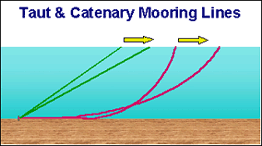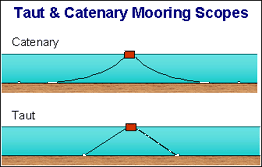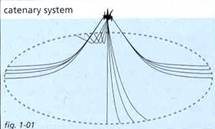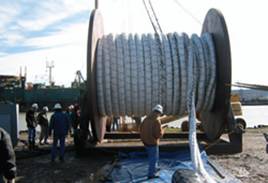
As the offshore industry moves in to increasing water depths, engineering challenges arise.
One of these challenges is the design of mooring solutions for offshore floating objects in deep waters. Floating objects that are to be kept in position for longer periods in time usually use mooring lines. When mooring lines are applied there are two possible configurations: taut moorings and catenary moorings.
Taut leg moorings are characterized by mooring lines that rise from the anchor under normal pretension, so there is no line on the seabed to lift as the line tension increases. Because of this, taut moorings work in a fundamentally different way to catenary moorings, their compliance deriving mainly from the elastic stretch of the lines, whereas a catenary mooring derives its compliance from the change in suspended line weight. The change in suspended weight is caused by the lifting of mooring line that lies on the seabed.




Synthetic Rope Moorings
Synthetic fibre ropes offer a potential solution to the weight problems of using steel mooring lines in deepwater as they have a very low weight in water.
Also, compared to steel, there are a vary large number of synthetic fibre material compositions with a wide range of material properties. A synthetic rope can therefore be designed to have properties that match the mooring requirements.


Combining steel mooring lines with synthetic rope moorings offers a solution for deepwater catenary mooring problems. When using the combination of steel and synthetic mooring lines, the challenge is to find the optimum ratio between steel cable and synthetic rope. Using too much steel results in undesirable heavy lines, using too much synthetic rope results in too much offset of the moored object. Unfortunately determining the optimum ratio is a complex matter. To assist you in finding this optimum we developed the catenary mooring tool, so you can find the best catenary mooring solution for your deepwater mooring problem.
(picture source: www.tensiontech.com/services/mooring.html)